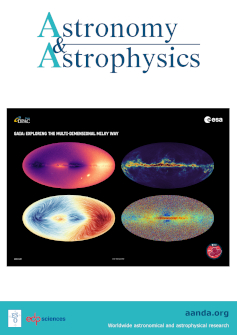明亮长寿命II型超新星的观测多样性
IF 5.4
2区 物理与天体物理
Q1 ASTRONOMY & ASTROPHYSICS
引用次数: 0
摘要
上下文。在各种类型的超新星(SNe)中,SN抛射物与星周物质(CSM)之间有很强的相互作用。这就提出了关于它们的起源和爆炸前不久的质量损失过程的问题。最近,明亮的长寿命的II型SN 2021irp被认为是与圆盘状CSM相互作用的标准II型SN。观测性质表明,它的祖先是一个双星系统中的大质量恒星(~ 8−18 M⊙),在爆炸前由于双星的相互作用而经历了一个质量抛射过程。类似的场景,即II型SN与CSM磁盘相互作用,也被用来解释一些II型SN的目的。在这里,我们研究了明亮的长寿命II型(21irp-like) SNe的观测特性的多样性。我们分析了它们的CSM性质的多样性,以了解它们的起源和质量损失机制以及它们与其他类型相互作用的swe的关系。我们对四个21irp样SNe进行了光度测定、光谱测定和/或偏振测定。在此基础上,结合SN 2021irp本身以及SNe 2010j1、2015da和2017hcc等已观测到的明亮且寿命长的II型超新星的观测数据,讨论了它们的CSM特征。这个SNe样品显示出明亮和长时间的光度演化,在光度演化中有一些变化(即使在爆炸后约200天,r/o波段的绝对亮度从~−17到~−20)。它们显示了几百天内主要以巴尔默线为特征的光球光谱,这些谱线的形状有一些变化。它们表现出高偏振度,偏振度略有变化(亮度峰值时为~ 1 ~ 3%),随时间迅速下降(从峰值前的~ 3 ~ 6%降至峰值后约200天的~ 1%)。总体观测性质与盘状CSM相互作用情景一致,即典型的II型SNe与盘状CSM相互作用。同时,观测性质的变化表明,CSM质量和CSM盘开口角度存在差异。CSM性质的这些变化很可能与祖星系统的双星参数和/或祖星和伴星的性质有关。本文章由计算机程序翻译,如有差异,请以英文原文为准。
Observational diversity of bright long-lived Type II supernovae
Context. In various types of supernovae (SNe), strong interaction between the SN ejecta and circumstellar material (CSM) has been reported. This raises questions about their progenitors and mass-loss processes shortly before the explosion. Recently, the bright long-lived Type II SN 2021irp was proposed to be a standard Type II SN interacting with disk-like CSM. The observational properties suggest that the progenitor was a massive star (∼8−18 M⊙) in a binary system and underwent a mass-ejection process due to the binary interaction just before the explosion. Similar scenarios, i.e., a Type II SN interacting with a CSM disk, have also been invoked to explain some Type IIn SNe.Aims. Here, we study the diversity of the observational properties of bright long-lived Type II (21irp-like) SNe. We analyze the diversity of their CSM properties, in order to understand their progenitors and mass-loss mechanisms and their relations with the other types of interacting SNe.Methods. We performed photometry, spectroscopy, and/or polarimetry for four 21irp-like SNe. Based on these observations as well as published data of SN 2021irp itself and well-observed bright and long-lived type II SNe including SNe 2010jl, 2015da, and 2017hcc, we discuss their CSM characteristics.Results. This sample of SNe shows luminous and long-lived photometric evolution, with some variations in the photometric evolution (from ∼−17 to ∼−20 absolute mag in the r/o band even at ∼200 days after the explosion). They show photospheric spectra characterized mainly by Balmer lines for several hundreds of days, with some variations in the shapes of the lines. They show high polarization with slight variations in the polarization degrees (∼1−3% at the brightness peak) with rapid declines with time (from ∼3−6% before the peak to ∼1% at ∼200 days after the peak). The general observational properties are consistent with the disk-CSM-interaction scenario, i.e., typical Type II SNe interacting with disk-like CSM. At the same time, the variation in the observational properties suggest diversity in the CSM mass and the opening angle of the CSM disk. These variations in the CSM properties are likely to be be related to the binary parameters of the progenitor systems and/or the properties of the progenitor and companion stars.
求助全文
通过发布文献求助,成功后即可免费获取论文全文。
去求助
来源期刊

Astronomy & Astrophysics
地学天文-天文与天体物理
CiteScore
10.20
自引率
27.70%
发文量
2105
审稿时长
1-2 weeks
期刊介绍:
Astronomy & Astrophysics is an international Journal that publishes papers on all aspects of astronomy and astrophysics (theoretical, observational, and instrumental) independently of the techniques used to obtain the results.
 求助内容:
求助内容: 应助结果提醒方式:
应助结果提醒方式:


